ACC539: Risk Management, Inventory, and Business Intelligence Report
VerifiedAdded on 2022/10/17
|13
|2396
|20
Report
AI Summary
This report provides an analysis of risk management systems, focusing on mitigation approaches to address organizational risks, including operational, material, strategic, security, reputation, and legal risks. It examines inventory control systems, differentiating between perpetual and periodic systems, and exploring the use of barcode and RFID technologies. The report includes a case study of Laurel Pty Ltd, identifying weaknesses in its inventory control system, highlighting the impact of internal controls, and suggesting prevention measures. Furthermore, it discusses the importance of Business Intelligence (BI) in decision-making, exploring BI dashboards and data mining techniques. The analysis covers key aspects of risk management, inventory control, and the application of BI to improve organizational performance and decision-making processes. The report concludes by emphasizing the importance of risk management and the use of technology and data analysis for sustained growth and profitability.
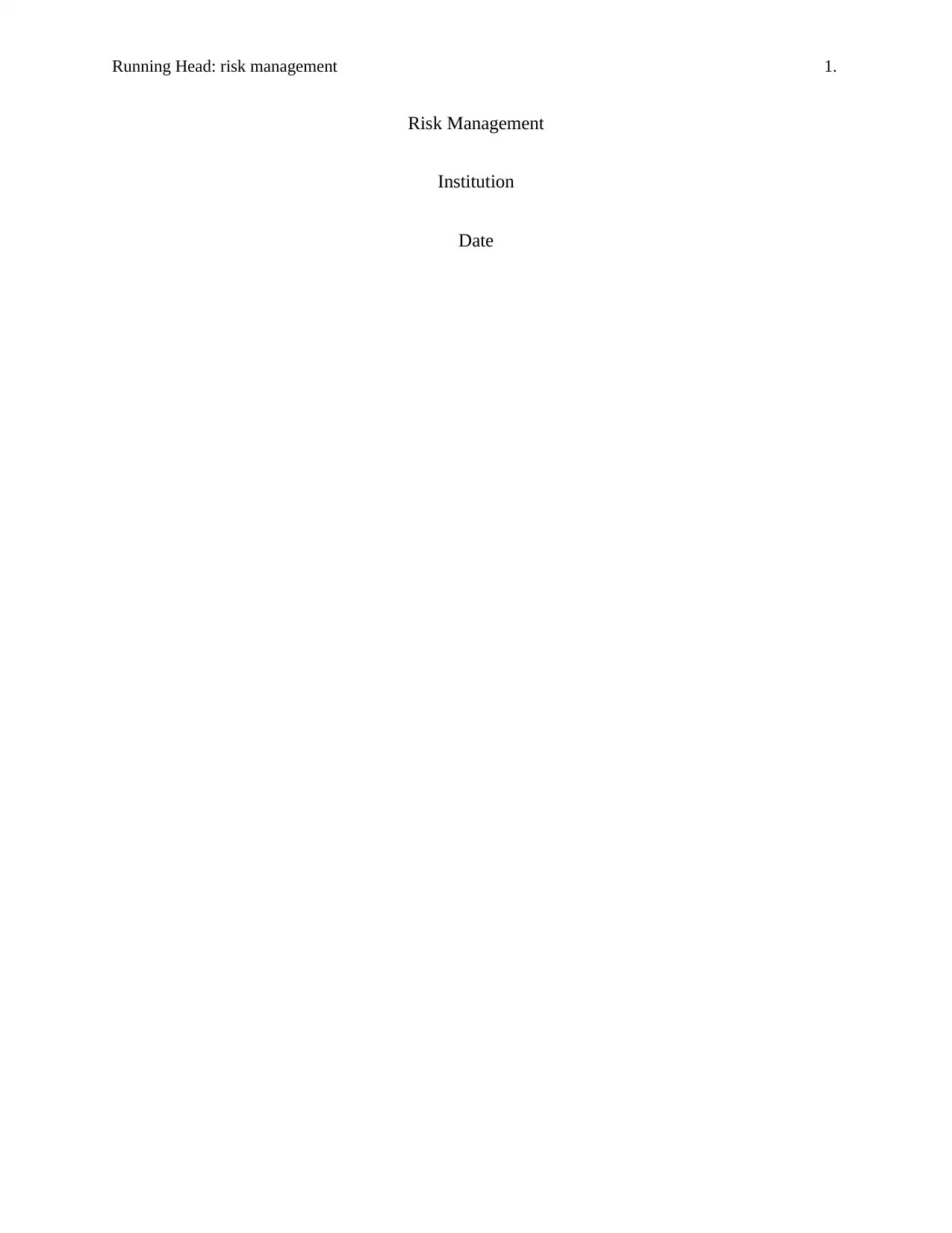
Running Head: risk management 1.
Risk Management
Institution
Date
Risk Management
Institution
Date
Paraphrase This Document
Need a fresh take? Get an instant paraphrase of this document with our AI Paraphraser
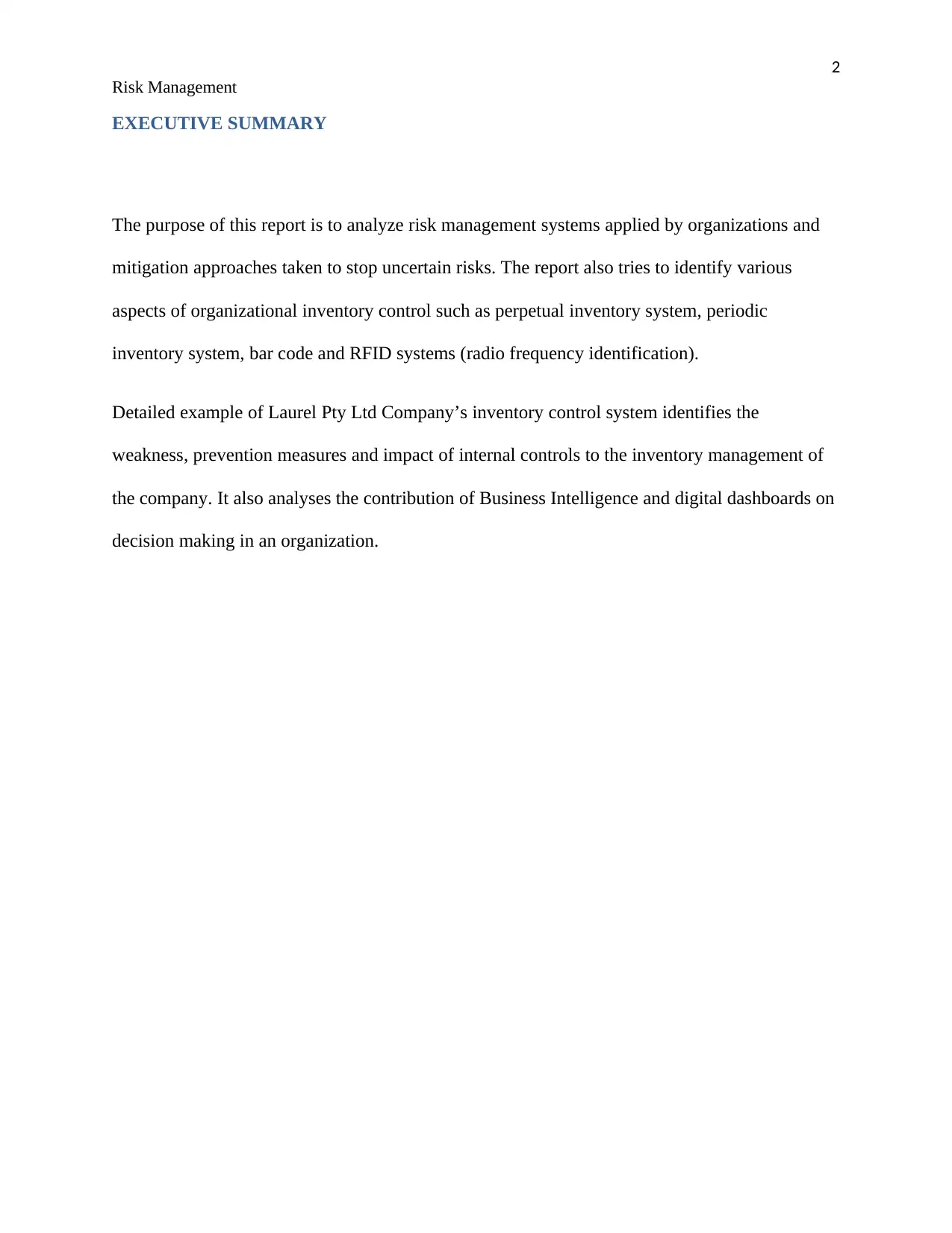
2
Risk Management
EXECUTIVE SUMMARY
The purpose of this report is to analyze risk management systems applied by organizations and
mitigation approaches taken to stop uncertain risks. The report also tries to identify various
aspects of organizational inventory control such as perpetual inventory system, periodic
inventory system, bar code and RFID systems (radio frequency identification).
Detailed example of Laurel Pty Ltd Company’s inventory control system identifies the
weakness, prevention measures and impact of internal controls to the inventory management of
the company. It also analyses the contribution of Business Intelligence and digital dashboards on
decision making in an organization.
Risk Management
EXECUTIVE SUMMARY
The purpose of this report is to analyze risk management systems applied by organizations and
mitigation approaches taken to stop uncertain risks. The report also tries to identify various
aspects of organizational inventory control such as perpetual inventory system, periodic
inventory system, bar code and RFID systems (radio frequency identification).
Detailed example of Laurel Pty Ltd Company’s inventory control system identifies the
weakness, prevention measures and impact of internal controls to the inventory management of
the company. It also analyses the contribution of Business Intelligence and digital dashboards on
decision making in an organization.
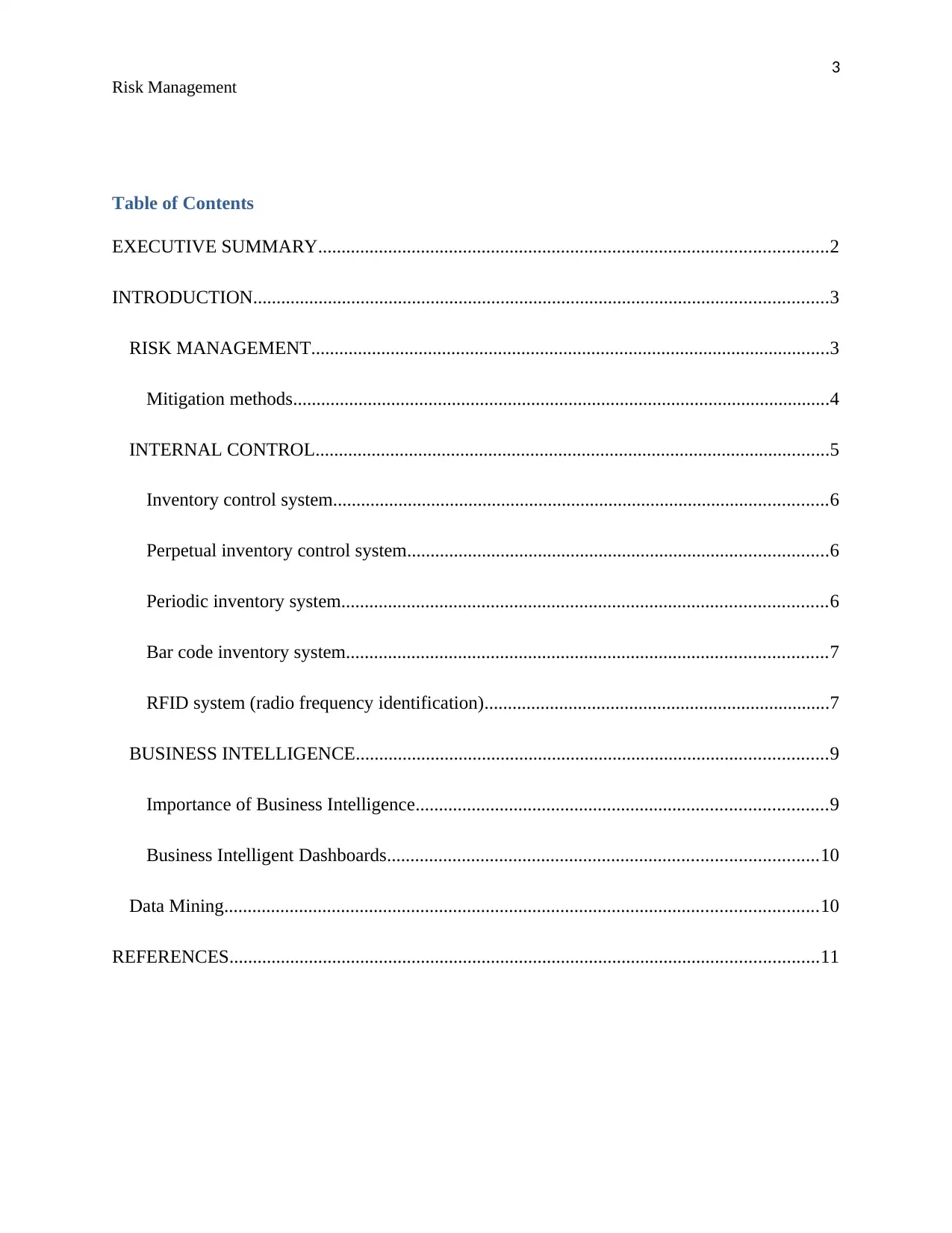
3
Risk Management
Table of Contents
EXECUTIVE SUMMARY.............................................................................................................2
INTRODUCTION...........................................................................................................................3
RISK MANAGEMENT...............................................................................................................3
Mitigation methods...................................................................................................................4
INTERNAL CONTROL..............................................................................................................5
Inventory control system..........................................................................................................6
Perpetual inventory control system..........................................................................................6
Periodic inventory system........................................................................................................6
Bar code inventory system.......................................................................................................7
RFID system (radio frequency identification)..........................................................................7
BUSINESS INTELLIGENCE.....................................................................................................9
Importance of Business Intelligence........................................................................................9
Business Intelligent Dashboards............................................................................................10
Data Mining...............................................................................................................................10
REFERENCES..............................................................................................................................11
Risk Management
Table of Contents
EXECUTIVE SUMMARY.............................................................................................................2
INTRODUCTION...........................................................................................................................3
RISK MANAGEMENT...............................................................................................................3
Mitigation methods...................................................................................................................4
INTERNAL CONTROL..............................................................................................................5
Inventory control system..........................................................................................................6
Perpetual inventory control system..........................................................................................6
Periodic inventory system........................................................................................................6
Bar code inventory system.......................................................................................................7
RFID system (radio frequency identification)..........................................................................7
BUSINESS INTELLIGENCE.....................................................................................................9
Importance of Business Intelligence........................................................................................9
Business Intelligent Dashboards............................................................................................10
Data Mining...............................................................................................................................10
REFERENCES..............................................................................................................................11
⊘ This is a preview!⊘
Do you want full access?
Subscribe today to unlock all pages.

Trusted by 1+ million students worldwide
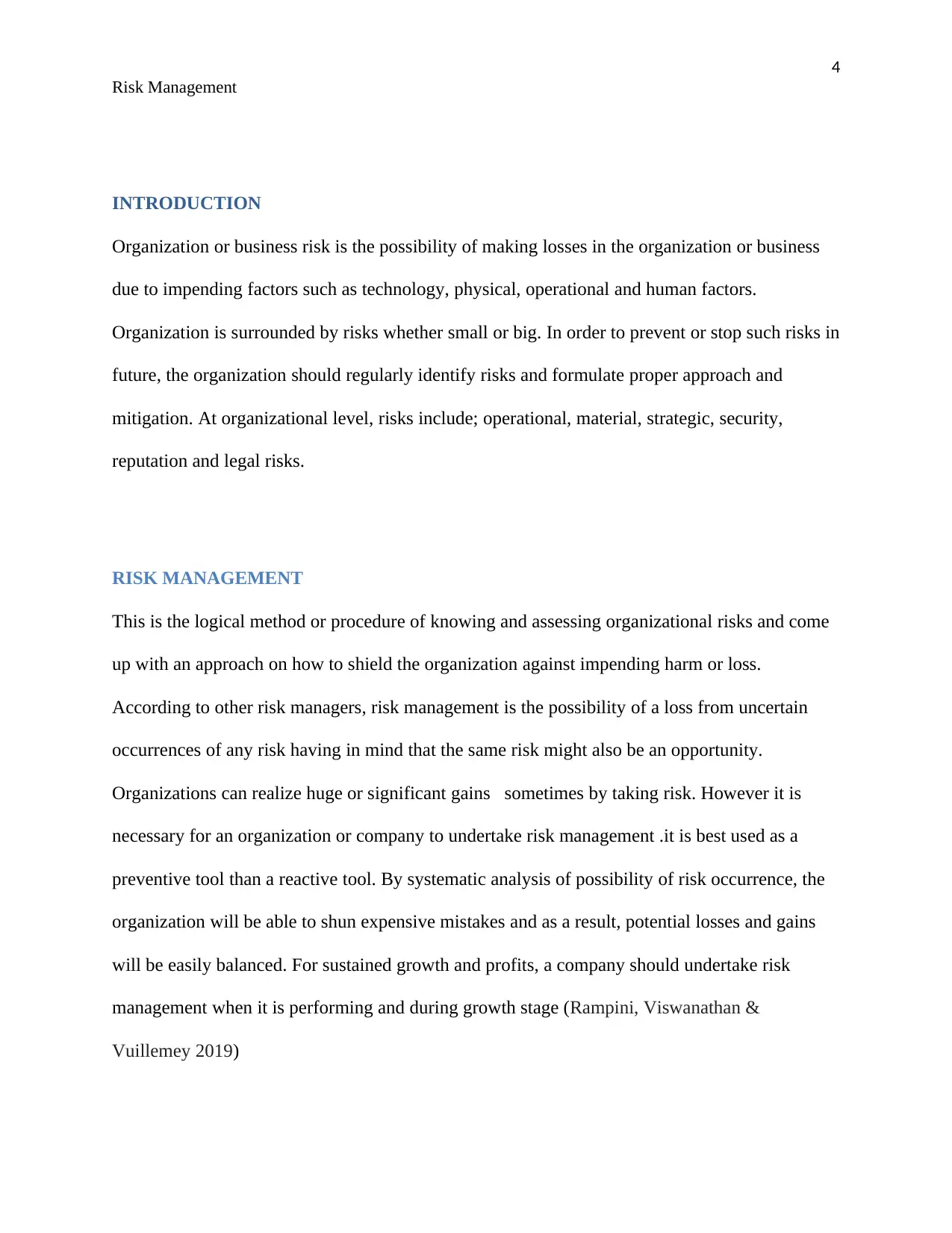
4
Risk Management
INTRODUCTION
Organization or business risk is the possibility of making losses in the organization or business
due to impending factors such as technology, physical, operational and human factors.
Organization is surrounded by risks whether small or big. In order to prevent or stop such risks in
future, the organization should regularly identify risks and formulate proper approach and
mitigation. At organizational level, risks include; operational, material, strategic, security,
reputation and legal risks.
RISK MANAGEMENT
This is the logical method or procedure of knowing and assessing organizational risks and come
up with an approach on how to shield the organization against impending harm or loss.
According to other risk managers, risk management is the possibility of a loss from uncertain
occurrences of any risk having in mind that the same risk might also be an opportunity.
Organizations can realize huge or significant gains sometimes by taking risk. However it is
necessary for an organization or company to undertake risk management .it is best used as a
preventive tool than a reactive tool. By systematic analysis of possibility of risk occurrence, the
organization will be able to shun expensive mistakes and as a result, potential losses and gains
will be easily balanced. For sustained growth and profits, a company should undertake risk
management when it is performing and during growth stage (Rampini, Viswanathan &
Vuillemey 2019)
Risk Management
INTRODUCTION
Organization or business risk is the possibility of making losses in the organization or business
due to impending factors such as technology, physical, operational and human factors.
Organization is surrounded by risks whether small or big. In order to prevent or stop such risks in
future, the organization should regularly identify risks and formulate proper approach and
mitigation. At organizational level, risks include; operational, material, strategic, security,
reputation and legal risks.
RISK MANAGEMENT
This is the logical method or procedure of knowing and assessing organizational risks and come
up with an approach on how to shield the organization against impending harm or loss.
According to other risk managers, risk management is the possibility of a loss from uncertain
occurrences of any risk having in mind that the same risk might also be an opportunity.
Organizations can realize huge or significant gains sometimes by taking risk. However it is
necessary for an organization or company to undertake risk management .it is best used as a
preventive tool than a reactive tool. By systematic analysis of possibility of risk occurrence, the
organization will be able to shun expensive mistakes and as a result, potential losses and gains
will be easily balanced. For sustained growth and profits, a company should undertake risk
management when it is performing and during growth stage (Rampini, Viswanathan &
Vuillemey 2019)
Paraphrase This Document
Need a fresh take? Get an instant paraphrase of this document with our AI Paraphraser
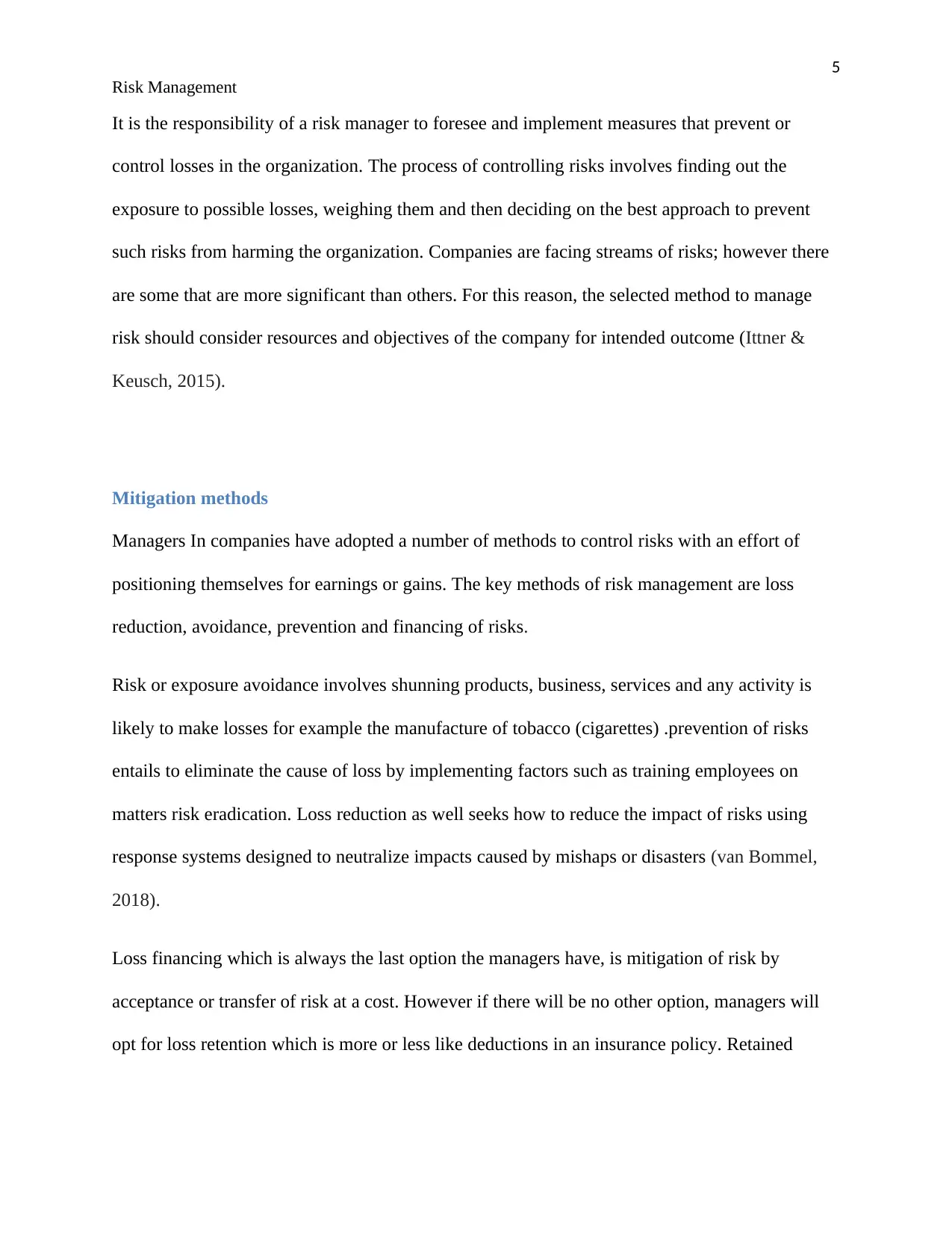
5
Risk Management
It is the responsibility of a risk manager to foresee and implement measures that prevent or
control losses in the organization. The process of controlling risks involves finding out the
exposure to possible losses, weighing them and then deciding on the best approach to prevent
such risks from harming the organization. Companies are facing streams of risks; however there
are some that are more significant than others. For this reason, the selected method to manage
risk should consider resources and objectives of the company for intended outcome (Ittner &
Keusch, 2015).
Mitigation methods
Managers In companies have adopted a number of methods to control risks with an effort of
positioning themselves for earnings or gains. The key methods of risk management are loss
reduction, avoidance, prevention and financing of risks.
Risk or exposure avoidance involves shunning products, business, services and any activity is
likely to make losses for example the manufacture of tobacco (cigarettes) .prevention of risks
entails to eliminate the cause of loss by implementing factors such as training employees on
matters risk eradication. Loss reduction as well seeks how to reduce the impact of risks using
response systems designed to neutralize impacts caused by mishaps or disasters (van Bommel,
2018).
Loss financing which is always the last option the managers have, is mitigation of risk by
acceptance or transfer of risk at a cost. However if there will be no other option, managers will
opt for loss retention which is more or less like deductions in an insurance policy. Retained
Risk Management
It is the responsibility of a risk manager to foresee and implement measures that prevent or
control losses in the organization. The process of controlling risks involves finding out the
exposure to possible losses, weighing them and then deciding on the best approach to prevent
such risks from harming the organization. Companies are facing streams of risks; however there
are some that are more significant than others. For this reason, the selected method to manage
risk should consider resources and objectives of the company for intended outcome (Ittner &
Keusch, 2015).
Mitigation methods
Managers In companies have adopted a number of methods to control risks with an effort of
positioning themselves for earnings or gains. The key methods of risk management are loss
reduction, avoidance, prevention and financing of risks.
Risk or exposure avoidance involves shunning products, business, services and any activity is
likely to make losses for example the manufacture of tobacco (cigarettes) .prevention of risks
entails to eliminate the cause of loss by implementing factors such as training employees on
matters risk eradication. Loss reduction as well seeks how to reduce the impact of risks using
response systems designed to neutralize impacts caused by mishaps or disasters (van Bommel,
2018).
Loss financing which is always the last option the managers have, is mitigation of risk by
acceptance or transfer of risk at a cost. However if there will be no other option, managers will
opt for loss retention which is more or less like deductions in an insurance policy. Retained
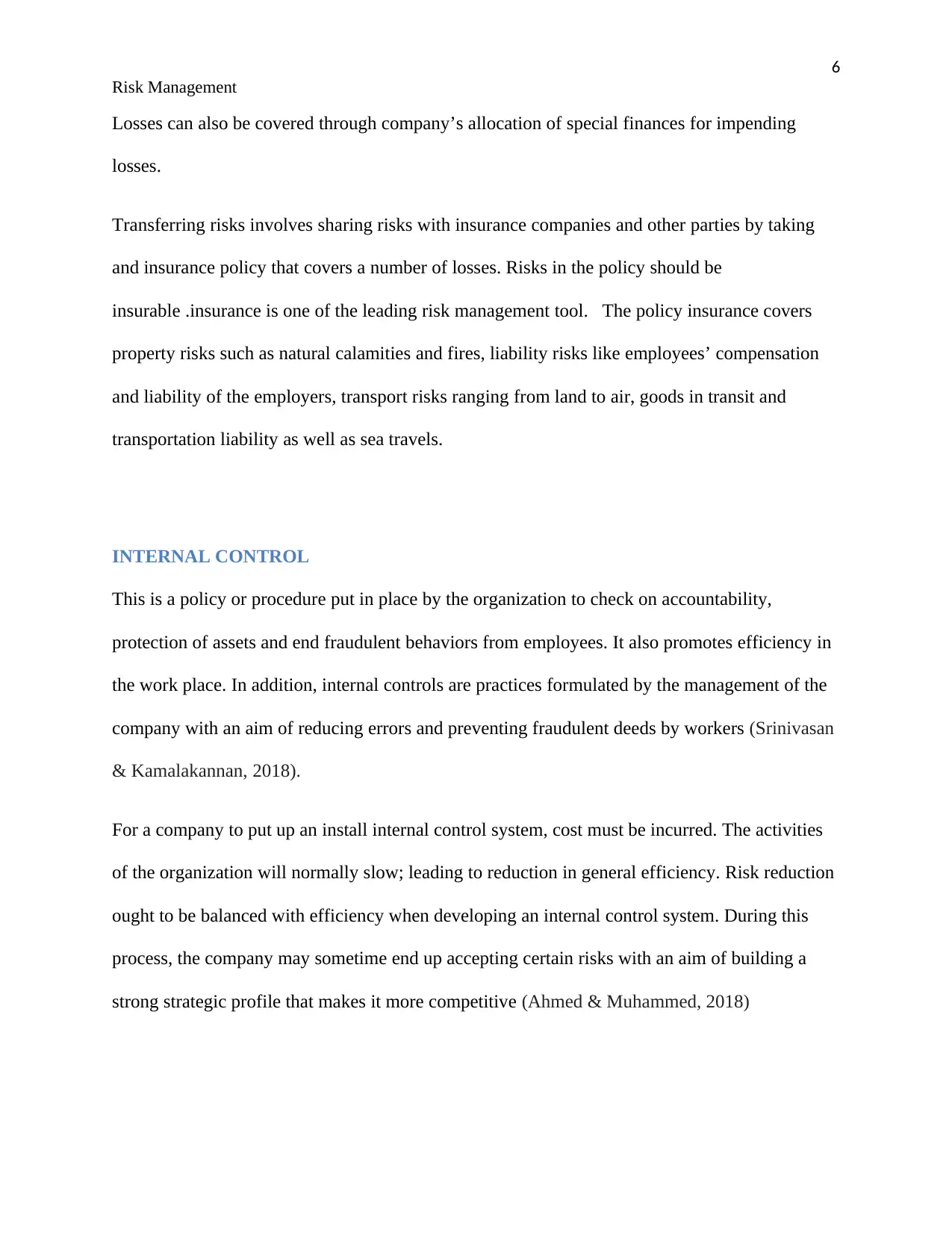
6
Risk Management
Losses can also be covered through company’s allocation of special finances for impending
losses.
Transferring risks involves sharing risks with insurance companies and other parties by taking
and insurance policy that covers a number of losses. Risks in the policy should be
insurable .insurance is one of the leading risk management tool. The policy insurance covers
property risks such as natural calamities and fires, liability risks like employees’ compensation
and liability of the employers, transport risks ranging from land to air, goods in transit and
transportation liability as well as sea travels.
INTERNAL CONTROL
This is a policy or procedure put in place by the organization to check on accountability,
protection of assets and end fraudulent behaviors from employees. It also promotes efficiency in
the work place. In addition, internal controls are practices formulated by the management of the
company with an aim of reducing errors and preventing fraudulent deeds by workers (Srinivasan
& Kamalakannan, 2018).
For a company to put up an install internal control system, cost must be incurred. The activities
of the organization will normally slow; leading to reduction in general efficiency. Risk reduction
ought to be balanced with efficiency when developing an internal control system. During this
process, the company may sometime end up accepting certain risks with an aim of building a
strong strategic profile that makes it more competitive (Ahmed & Muhammed, 2018)
Risk Management
Losses can also be covered through company’s allocation of special finances for impending
losses.
Transferring risks involves sharing risks with insurance companies and other parties by taking
and insurance policy that covers a number of losses. Risks in the policy should be
insurable .insurance is one of the leading risk management tool. The policy insurance covers
property risks such as natural calamities and fires, liability risks like employees’ compensation
and liability of the employers, transport risks ranging from land to air, goods in transit and
transportation liability as well as sea travels.
INTERNAL CONTROL
This is a policy or procedure put in place by the organization to check on accountability,
protection of assets and end fraudulent behaviors from employees. It also promotes efficiency in
the work place. In addition, internal controls are practices formulated by the management of the
company with an aim of reducing errors and preventing fraudulent deeds by workers (Srinivasan
& Kamalakannan, 2018).
For a company to put up an install internal control system, cost must be incurred. The activities
of the organization will normally slow; leading to reduction in general efficiency. Risk reduction
ought to be balanced with efficiency when developing an internal control system. During this
process, the company may sometime end up accepting certain risks with an aim of building a
strong strategic profile that makes it more competitive (Ahmed & Muhammed, 2018)
⊘ This is a preview!⊘
Do you want full access?
Subscribe today to unlock all pages.

Trusted by 1+ million students worldwide
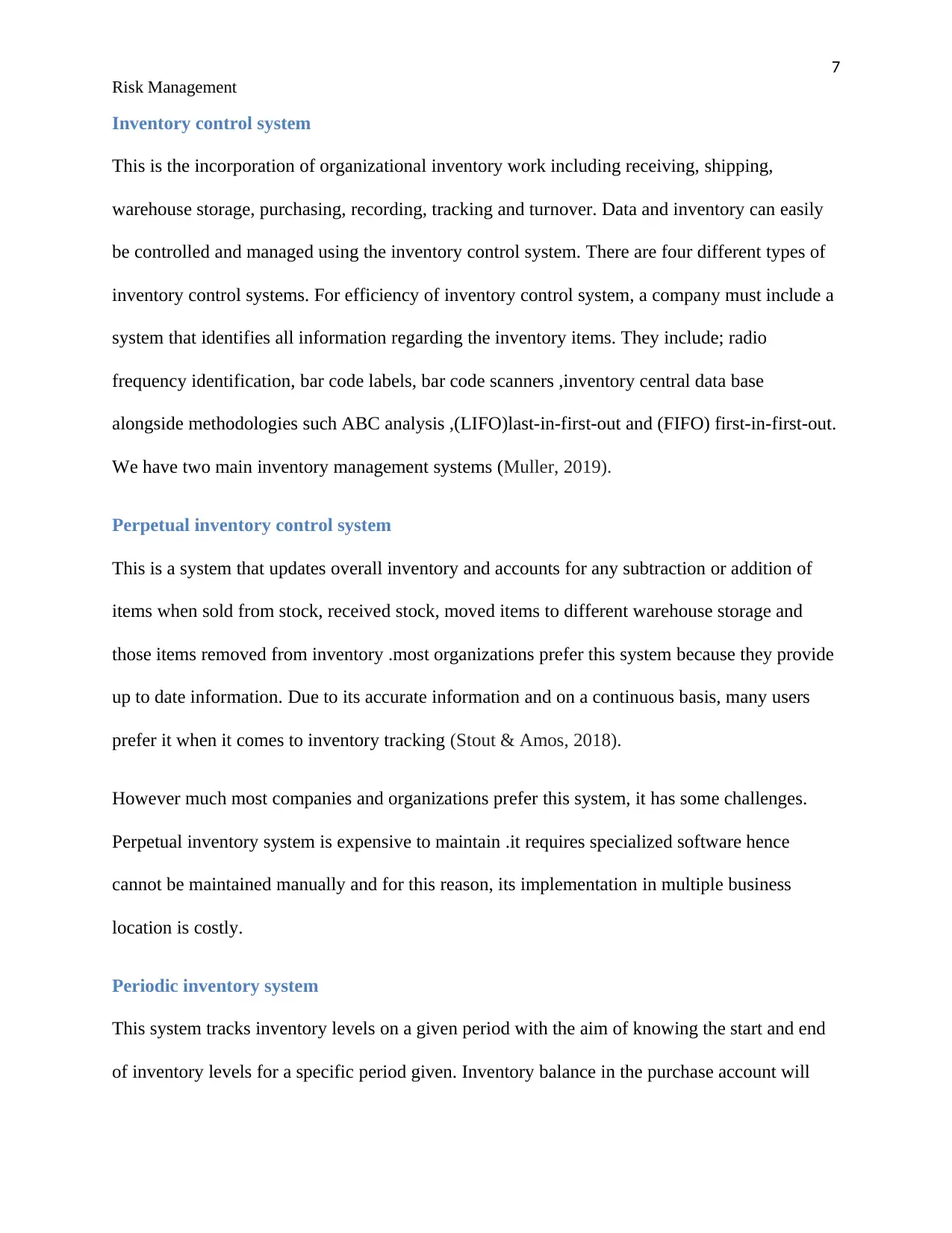
7
Risk Management
Inventory control system
This is the incorporation of organizational inventory work including receiving, shipping,
warehouse storage, purchasing, recording, tracking and turnover. Data and inventory can easily
be controlled and managed using the inventory control system. There are four different types of
inventory control systems. For efficiency of inventory control system, a company must include a
system that identifies all information regarding the inventory items. They include; radio
frequency identification, bar code labels, bar code scanners ,inventory central data base
alongside methodologies such ABC analysis ,(LIFO)last-in-first-out and (FIFO) first-in-first-out.
We have two main inventory management systems (Muller, 2019).
Perpetual inventory control system
This is a system that updates overall inventory and accounts for any subtraction or addition of
items when sold from stock, received stock, moved items to different warehouse storage and
those items removed from inventory .most organizations prefer this system because they provide
up to date information. Due to its accurate information and on a continuous basis, many users
prefer it when it comes to inventory tracking (Stout & Amos, 2018).
However much most companies and organizations prefer this system, it has some challenges.
Perpetual inventory system is expensive to maintain .it requires specialized software hence
cannot be maintained manually and for this reason, its implementation in multiple business
location is costly.
Periodic inventory system
This system tracks inventory levels on a given period with the aim of knowing the start and end
of inventory levels for a specific period given. Inventory balance in the purchase account will
Risk Management
Inventory control system
This is the incorporation of organizational inventory work including receiving, shipping,
warehouse storage, purchasing, recording, tracking and turnover. Data and inventory can easily
be controlled and managed using the inventory control system. There are four different types of
inventory control systems. For efficiency of inventory control system, a company must include a
system that identifies all information regarding the inventory items. They include; radio
frequency identification, bar code labels, bar code scanners ,inventory central data base
alongside methodologies such ABC analysis ,(LIFO)last-in-first-out and (FIFO) first-in-first-out.
We have two main inventory management systems (Muller, 2019).
Perpetual inventory control system
This is a system that updates overall inventory and accounts for any subtraction or addition of
items when sold from stock, received stock, moved items to different warehouse storage and
those items removed from inventory .most organizations prefer this system because they provide
up to date information. Due to its accurate information and on a continuous basis, many users
prefer it when it comes to inventory tracking (Stout & Amos, 2018).
However much most companies and organizations prefer this system, it has some challenges.
Perpetual inventory system is expensive to maintain .it requires specialized software hence
cannot be maintained manually and for this reason, its implementation in multiple business
location is costly.
Periodic inventory system
This system tracks inventory levels on a given period with the aim of knowing the start and end
of inventory levels for a specific period given. Inventory balance in the purchase account will
Paraphrase This Document
Need a fresh take? Get an instant paraphrase of this document with our AI Paraphraser
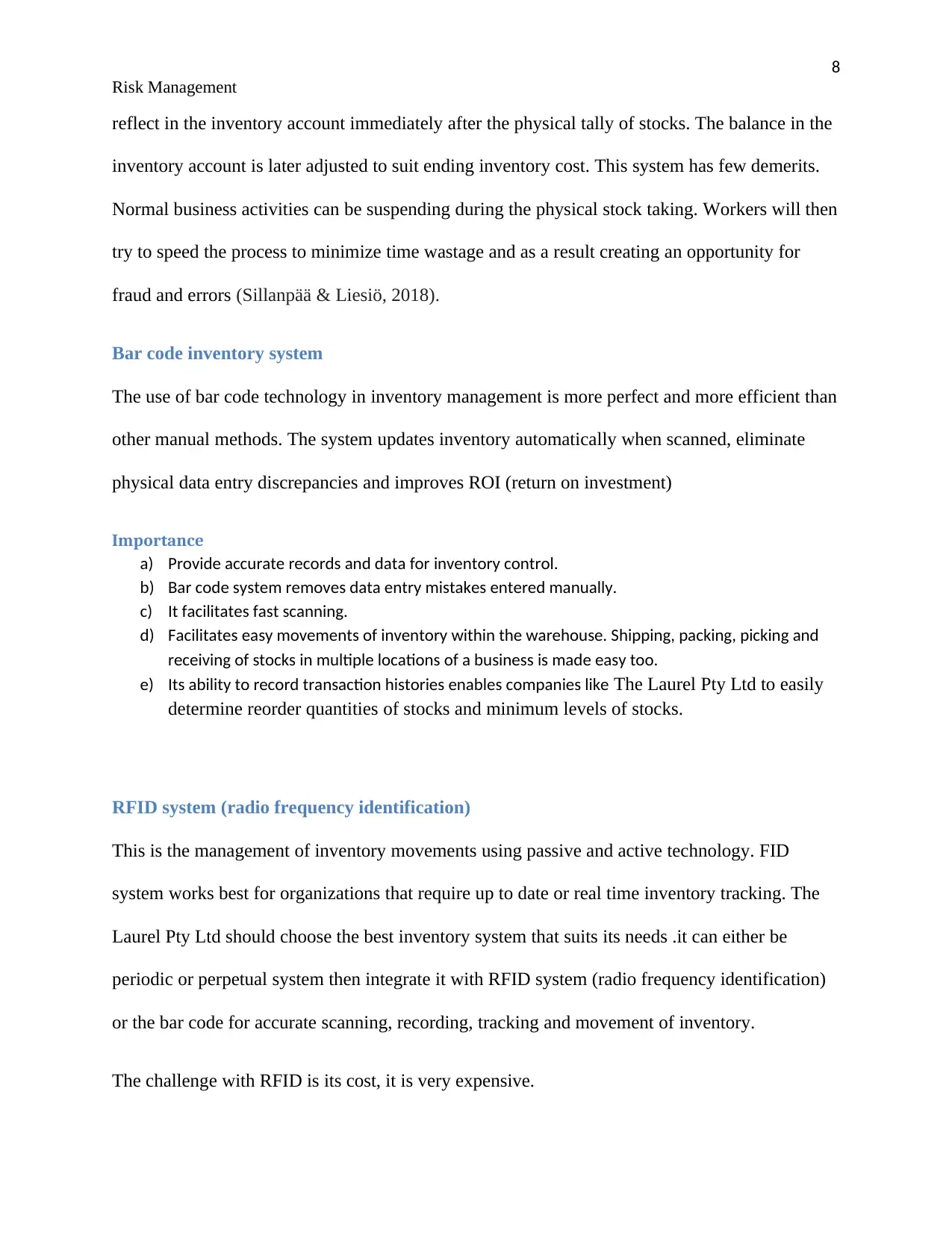
8
Risk Management
reflect in the inventory account immediately after the physical tally of stocks. The balance in the
inventory account is later adjusted to suit ending inventory cost. This system has few demerits.
Normal business activities can be suspending during the physical stock taking. Workers will then
try to speed the process to minimize time wastage and as a result creating an opportunity for
fraud and errors (Sillanpää & Liesiö, 2018).
Bar code inventory system
The use of bar code technology in inventory management is more perfect and more efficient than
other manual methods. The system updates inventory automatically when scanned, eliminate
physical data entry discrepancies and improves ROI (return on investment)
Importance
a) Provide accurate records and data for inventory control.
b) Bar code system removes data entry mistakes entered manually.
c) It facilitates fast scanning.
d) Facilitates easy movements of inventory within the warehouse. Shipping, packing, picking and
receiving of stocks in multiple locations of a business is made easy too.
e) Its ability to record transaction histories enables companies like The Laurel Pty Ltd to easily
determine reorder quantities of stocks and minimum levels of stocks.
RFID system (radio frequency identification)
This is the management of inventory movements using passive and active technology. FID
system works best for organizations that require up to date or real time inventory tracking. The
Laurel Pty Ltd should choose the best inventory system that suits its needs .it can either be
periodic or perpetual system then integrate it with RFID system (radio frequency identification)
or the bar code for accurate scanning, recording, tracking and movement of inventory.
The challenge with RFID is its cost, it is very expensive.
Risk Management
reflect in the inventory account immediately after the physical tally of stocks. The balance in the
inventory account is later adjusted to suit ending inventory cost. This system has few demerits.
Normal business activities can be suspending during the physical stock taking. Workers will then
try to speed the process to minimize time wastage and as a result creating an opportunity for
fraud and errors (Sillanpää & Liesiö, 2018).
Bar code inventory system
The use of bar code technology in inventory management is more perfect and more efficient than
other manual methods. The system updates inventory automatically when scanned, eliminate
physical data entry discrepancies and improves ROI (return on investment)
Importance
a) Provide accurate records and data for inventory control.
b) Bar code system removes data entry mistakes entered manually.
c) It facilitates fast scanning.
d) Facilitates easy movements of inventory within the warehouse. Shipping, packing, picking and
receiving of stocks in multiple locations of a business is made easy too.
e) Its ability to record transaction histories enables companies like The Laurel Pty Ltd to easily
determine reorder quantities of stocks and minimum levels of stocks.
RFID system (radio frequency identification)
This is the management of inventory movements using passive and active technology. FID
system works best for organizations that require up to date or real time inventory tracking. The
Laurel Pty Ltd should choose the best inventory system that suits its needs .it can either be
periodic or perpetual system then integrate it with RFID system (radio frequency identification)
or the bar code for accurate scanning, recording, tracking and movement of inventory.
The challenge with RFID is its cost, it is very expensive.
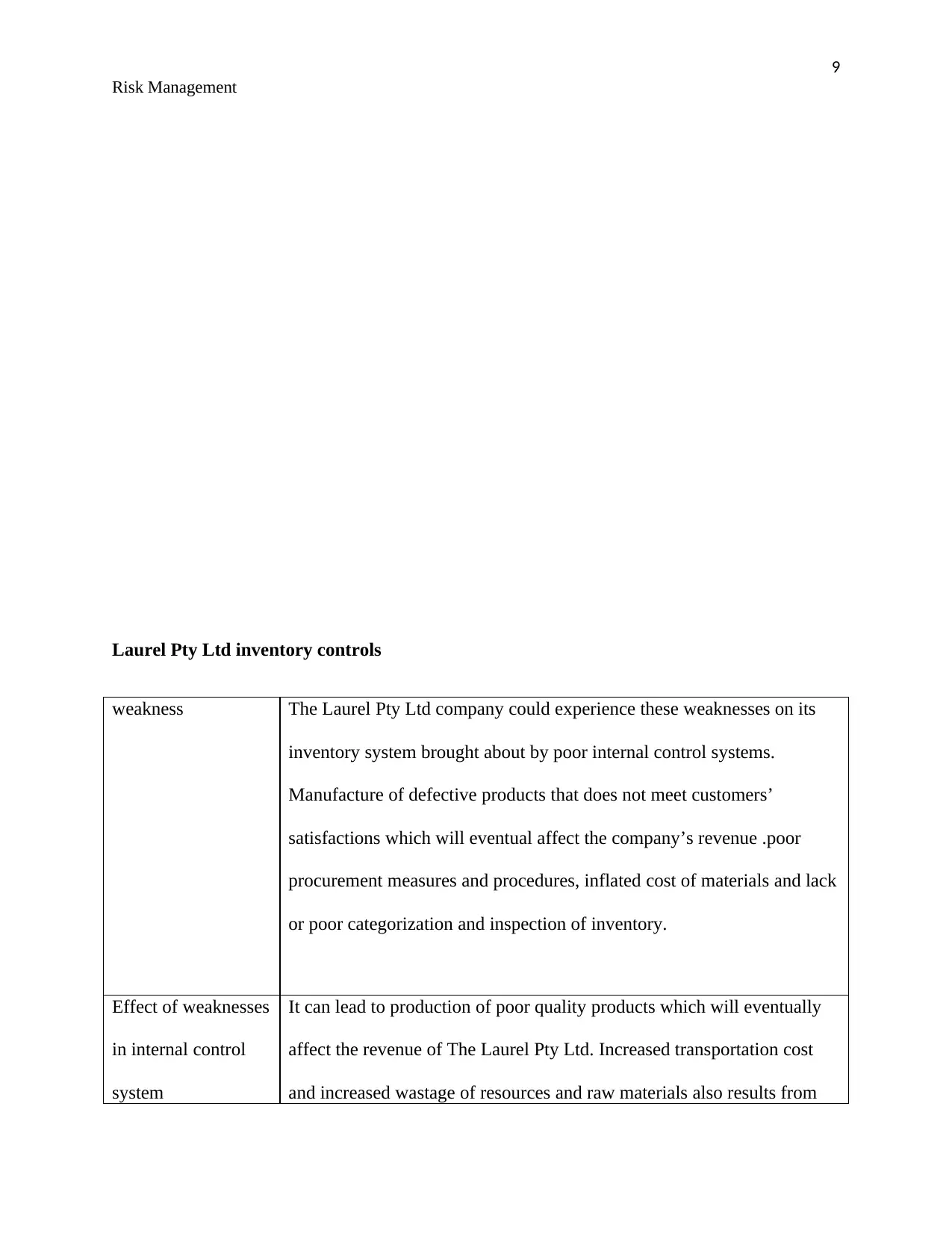
9
Risk Management
Laurel Pty Ltd inventory controls
weakness The Laurel Pty Ltd company could experience these weaknesses on its
inventory system brought about by poor internal control systems.
Manufacture of defective products that does not meet customers’
satisfactions which will eventual affect the company’s revenue .poor
procurement measures and procedures, inflated cost of materials and lack
or poor categorization and inspection of inventory.
Effect of weaknesses
in internal control
system
It can lead to production of poor quality products which will eventually
affect the revenue of The Laurel Pty Ltd. Increased transportation cost
and increased wastage of resources and raw materials also results from
Risk Management
Laurel Pty Ltd inventory controls
weakness The Laurel Pty Ltd company could experience these weaknesses on its
inventory system brought about by poor internal control systems.
Manufacture of defective products that does not meet customers’
satisfactions which will eventual affect the company’s revenue .poor
procurement measures and procedures, inflated cost of materials and lack
or poor categorization and inspection of inventory.
Effect of weaknesses
in internal control
system
It can lead to production of poor quality products which will eventually
affect the revenue of The Laurel Pty Ltd. Increased transportation cost
and increased wastage of resources and raw materials also results from
⊘ This is a preview!⊘
Do you want full access?
Subscribe today to unlock all pages.

Trusted by 1+ million students worldwide
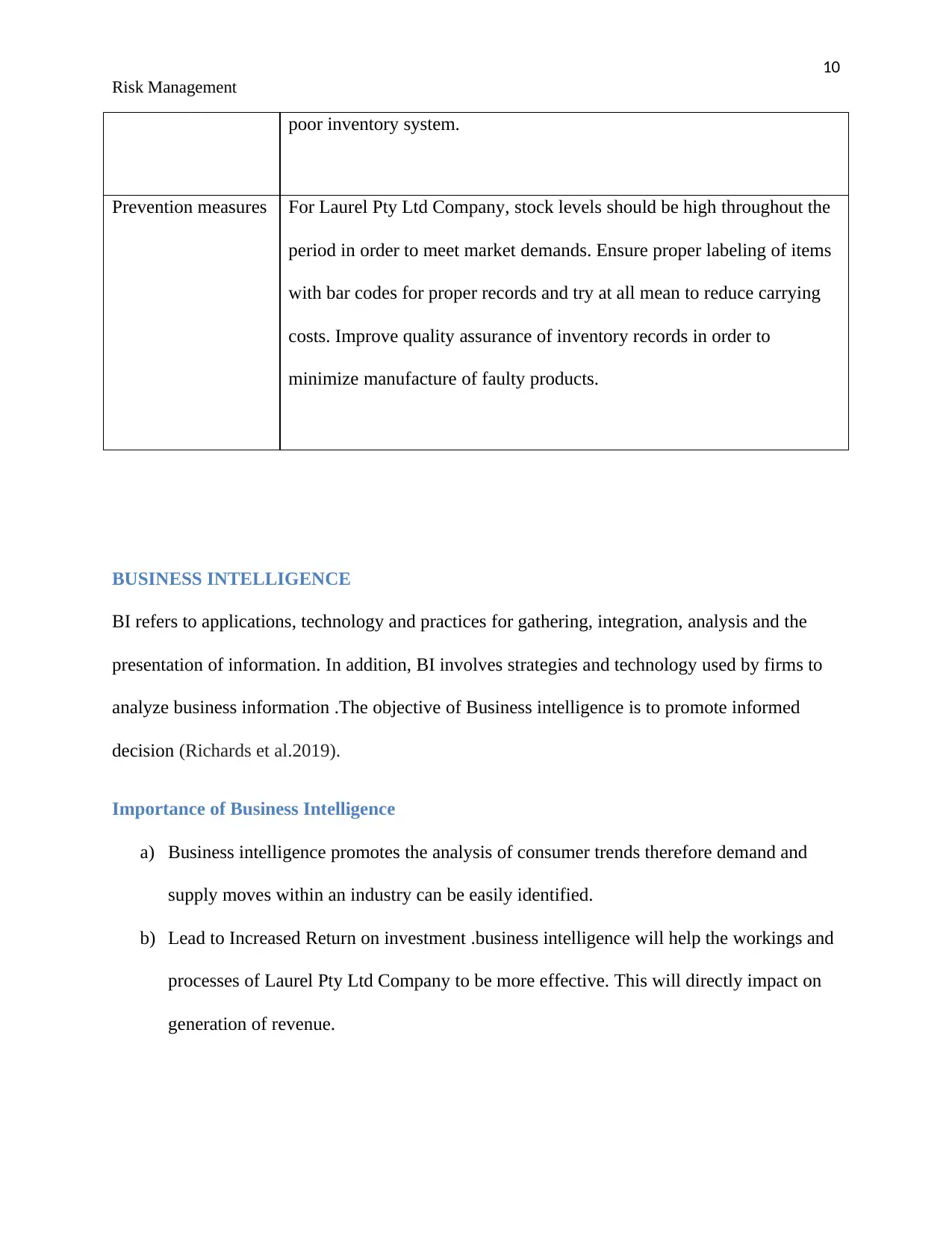
10
Risk Management
poor inventory system.
Prevention measures For Laurel Pty Ltd Company, stock levels should be high throughout the
period in order to meet market demands. Ensure proper labeling of items
with bar codes for proper records and try at all mean to reduce carrying
costs. Improve quality assurance of inventory records in order to
minimize manufacture of faulty products.
BUSINESS INTELLIGENCE
BI refers to applications, technology and practices for gathering, integration, analysis and the
presentation of information. In addition, BI involves strategies and technology used by firms to
analyze business information .The objective of Business intelligence is to promote informed
decision (Richards et al.2019).
Importance of Business Intelligence
a) Business intelligence promotes the analysis of consumer trends therefore demand and
supply moves within an industry can be easily identified.
b) Lead to Increased Return on investment .business intelligence will help the workings and
processes of Laurel Pty Ltd Company to be more effective. This will directly impact on
generation of revenue.
Risk Management
poor inventory system.
Prevention measures For Laurel Pty Ltd Company, stock levels should be high throughout the
period in order to meet market demands. Ensure proper labeling of items
with bar codes for proper records and try at all mean to reduce carrying
costs. Improve quality assurance of inventory records in order to
minimize manufacture of faulty products.
BUSINESS INTELLIGENCE
BI refers to applications, technology and practices for gathering, integration, analysis and the
presentation of information. In addition, BI involves strategies and technology used by firms to
analyze business information .The objective of Business intelligence is to promote informed
decision (Richards et al.2019).
Importance of Business Intelligence
a) Business intelligence promotes the analysis of consumer trends therefore demand and
supply moves within an industry can be easily identified.
b) Lead to Increased Return on investment .business intelligence will help the workings and
processes of Laurel Pty Ltd Company to be more effective. This will directly impact on
generation of revenue.
Paraphrase This Document
Need a fresh take? Get an instant paraphrase of this document with our AI Paraphraser
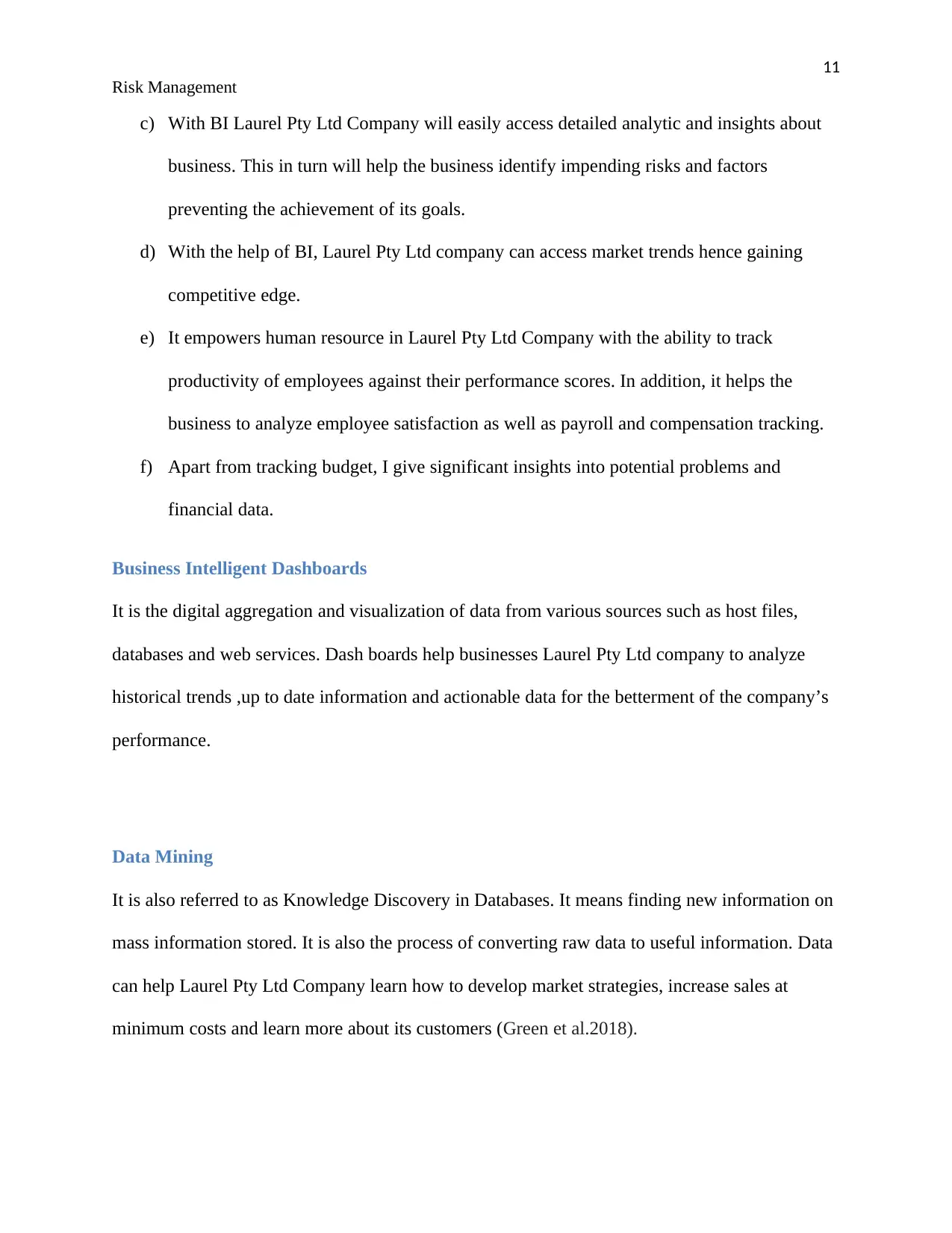
11
Risk Management
c) With BI Laurel Pty Ltd Company will easily access detailed analytic and insights about
business. This in turn will help the business identify impending risks and factors
preventing the achievement of its goals.
d) With the help of BI, Laurel Pty Ltd company can access market trends hence gaining
competitive edge.
e) It empowers human resource in Laurel Pty Ltd Company with the ability to track
productivity of employees against their performance scores. In addition, it helps the
business to analyze employee satisfaction as well as payroll and compensation tracking.
f) Apart from tracking budget, I give significant insights into potential problems and
financial data.
Business Intelligent Dashboards
It is the digital aggregation and visualization of data from various sources such as host files,
databases and web services. Dash boards help businesses Laurel Pty Ltd company to analyze
historical trends ,up to date information and actionable data for the betterment of the company’s
performance.
Data Mining
It is also referred to as Knowledge Discovery in Databases. It means finding new information on
mass information stored. It is also the process of converting raw data to useful information. Data
can help Laurel Pty Ltd Company learn how to develop market strategies, increase sales at
minimum costs and learn more about its customers (Green et al.2018).
Risk Management
c) With BI Laurel Pty Ltd Company will easily access detailed analytic and insights about
business. This in turn will help the business identify impending risks and factors
preventing the achievement of its goals.
d) With the help of BI, Laurel Pty Ltd company can access market trends hence gaining
competitive edge.
e) It empowers human resource in Laurel Pty Ltd Company with the ability to track
productivity of employees against their performance scores. In addition, it helps the
business to analyze employee satisfaction as well as payroll and compensation tracking.
f) Apart from tracking budget, I give significant insights into potential problems and
financial data.
Business Intelligent Dashboards
It is the digital aggregation and visualization of data from various sources such as host files,
databases and web services. Dash boards help businesses Laurel Pty Ltd company to analyze
historical trends ,up to date information and actionable data for the betterment of the company’s
performance.
Data Mining
It is also referred to as Knowledge Discovery in Databases. It means finding new information on
mass information stored. It is also the process of converting raw data to useful information. Data
can help Laurel Pty Ltd Company learn how to develop market strategies, increase sales at
minimum costs and learn more about its customers (Green et al.2018).
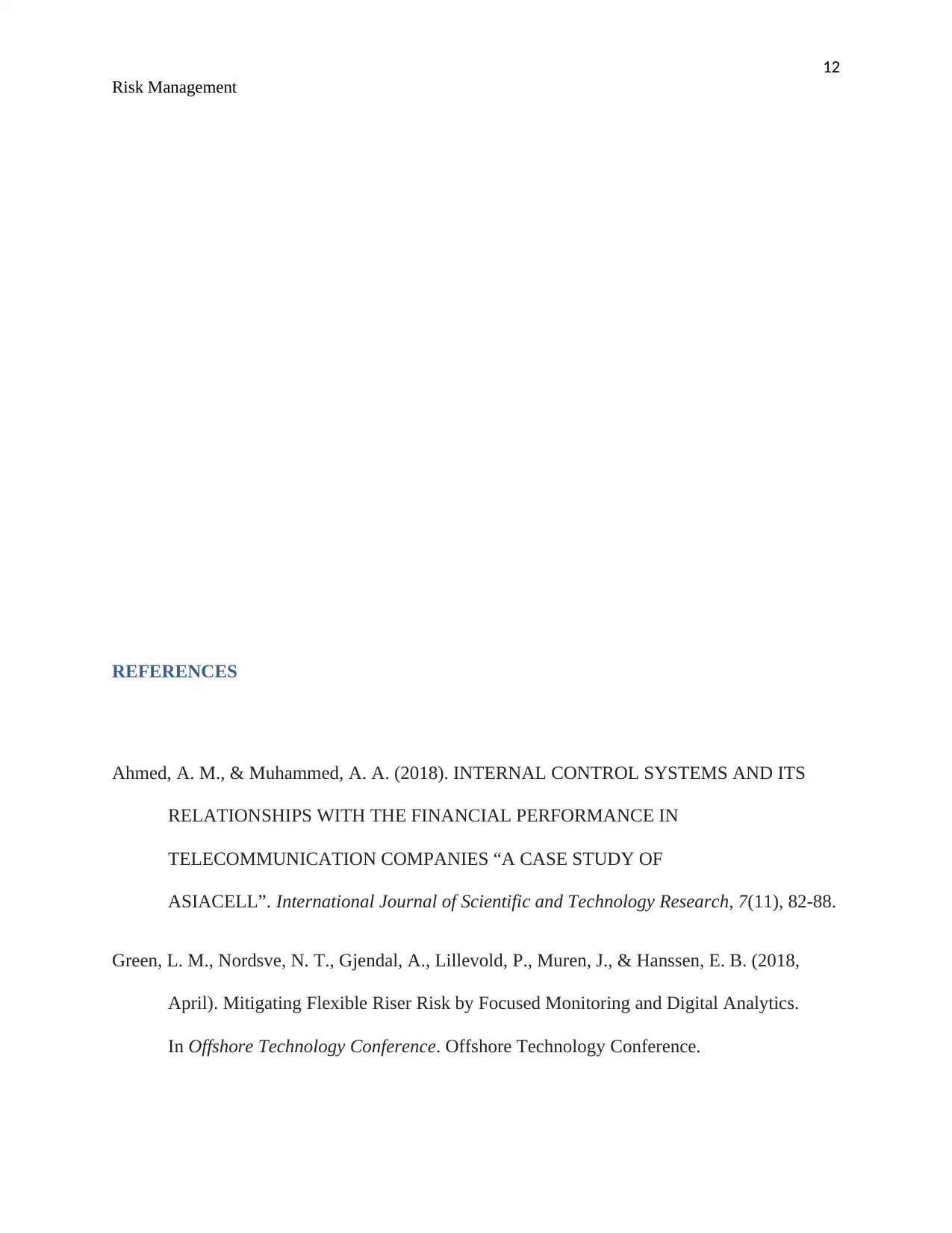
12
Risk Management
REFERENCES
Ahmed, A. M., & Muhammed, A. A. (2018). INTERNAL CONTROL SYSTEMS AND ITS
RELATIONSHIPS WITH THE FINANCIAL PERFORMANCE IN
TELECOMMUNICATION COMPANIES “A CASE STUDY OF
ASIACELL”. International Journal of Scientific and Technology Research, 7(11), 82-88.
Green, L. M., Nordsve, N. T., Gjendal, A., Lillevold, P., Muren, J., & Hanssen, E. B. (2018,
April). Mitigating Flexible Riser Risk by Focused Monitoring and Digital Analytics.
In Offshore Technology Conference. Offshore Technology Conference.
Risk Management
REFERENCES
Ahmed, A. M., & Muhammed, A. A. (2018). INTERNAL CONTROL SYSTEMS AND ITS
RELATIONSHIPS WITH THE FINANCIAL PERFORMANCE IN
TELECOMMUNICATION COMPANIES “A CASE STUDY OF
ASIACELL”. International Journal of Scientific and Technology Research, 7(11), 82-88.
Green, L. M., Nordsve, N. T., Gjendal, A., Lillevold, P., Muren, J., & Hanssen, E. B. (2018,
April). Mitigating Flexible Riser Risk by Focused Monitoring and Digital Analytics.
In Offshore Technology Conference. Offshore Technology Conference.
⊘ This is a preview!⊘
Do you want full access?
Subscribe today to unlock all pages.

Trusted by 1+ million students worldwide
1 out of 13
Related Documents
Your All-in-One AI-Powered Toolkit for Academic Success.
+13062052269
info@desklib.com
Available 24*7 on WhatsApp / Email
![[object Object]](/_next/static/media/star-bottom.7253800d.svg)
Unlock your academic potential
Copyright © 2020–2025 A2Z Services. All Rights Reserved. Developed and managed by ZUCOL.



